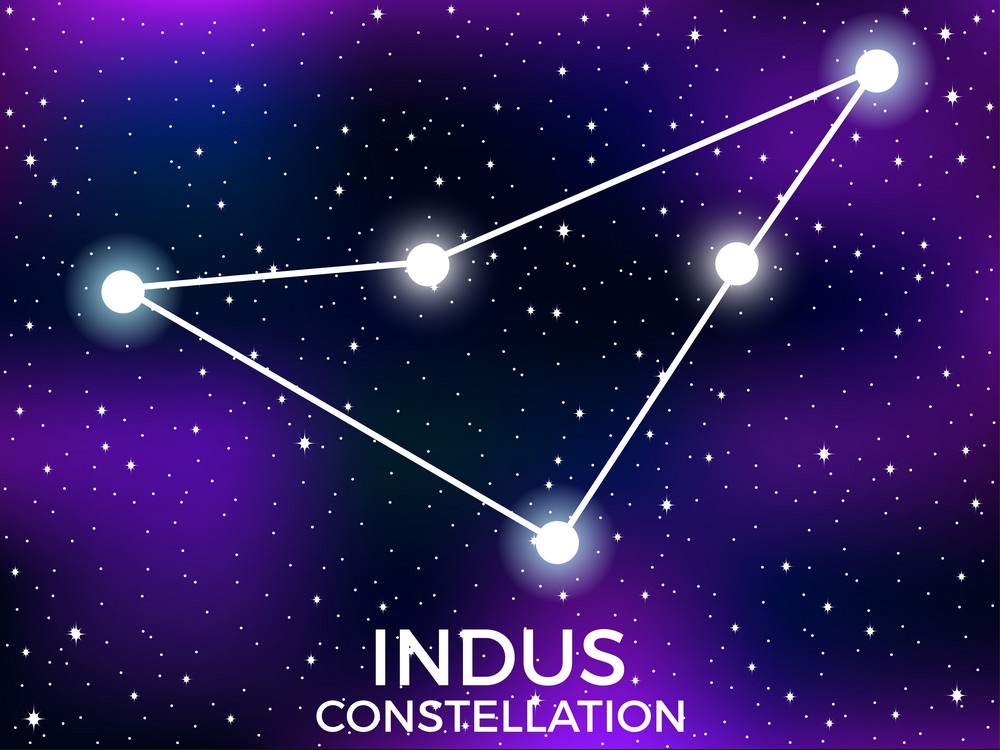
The Constellation Indus – Facts in brief:
What is it? –
Indus Constellation, also known as the Indian Constellation, is regarded as a fairly small and faint constellation in the Southern Hemisphere. It is listed as the 49th largest Constellation as it fills around 0.7% of the night sky. The Constellation of Indus is not associated with any myths but it is believed to resemble a naked man, like a hunter, holding arrows in both hands, but without a bow.
The name ‘Indus’ is Latin for the Indian and its Latin genitive ‘indi’ is sometimes abbreviated to ‘ind’.
Its shape resembles the outline of an elongated right angled triangle, imagined as a muscular man holding an arrow up high by one hand and other arrows grasped in the other hand.
It is often referred to as a native Indian man in several cultures, from regions stretching from Madagascar to the East Indies.
Where is it located? –
The Indus Constellation is positioned in the fourth quadrant of the Southern Hemisphere, south of the ecliptic plane (which is different from the celestial equator). Being located south of the celestial equator makes it more visible from the Southern Hemisphere.
It is sometimes referred to as being located in the SQ4 Quadrant.
FACT: The ecliptic is the imaginary line tracing the route that The Sun, the Moon, and the Planets take across the sky, over the year.
The plane of the Milky Way passes close the constellation of Indus. The Constellation of Indus is not considered to be a circumpolar constellation as it is not visible throughout the year in Southern latitudes. It is best seen in the month of September.
Circumpolar Constellations
There are 5 Constellations that are visible throughout the year, from most locations located north of the celestial equator, making them Circumpolar, they are:
- Cassiopeia Constellation
- Cepheus Constellation
- Draco Constellation
- Ursa Major Constellation
- Ursa Minor Constellation
FACT: A constellation that is visible all year round is known as a Circumpolar Constellation.
There are 3 Southern Constellations that are also circumpolar –
- Carina Constellation
- Centaurus Constellation
- Crux Constellation
Where can it be seen?
Co-ordinates of a right ascension, or left ascension and their declination are used to locate all of the Constellations, like Indus.
Indus is most prominent in the Southern Hemisphere.
The Indus Constellation lies at a 21 hours right ascension and a declination of 50 degrees South.
It’s more easily visible from the Southern Hemisphere at latitudes between +15 degrees and -90 degrees and covers an area of 294 square degrees in the Southern sky.
How was it formed, found and named?
Sea navigators, explorers, astronomers, and cartographers, throughout the ages, have observed the Constellations.
The Indus Constellation is not one of the original 48 Constellations devised and catalogued by the Greek astronomer Claudius Ptolemy, around 140 AD.
The Dutch influence
It was in the 16th Century, around 1595, that the first Dutch sea voyage to the East Indies took place.
These voyages enabled Dutch navigators and cartographers Pieter Dirkzoon Keyser and Frederick de Houtman, (students of Petrus Plancius) to make astronomical observations on their sea voyages of the bright stars and constellations in the night sky.
It was on one such voyage to the East Indies that Pieter Dirkzoon Keyser catalogued around 130 Stars and recorded 12 new Constellations in the Southern Celestial Sky.
It was in fact the Dutch astronomer Petrus Plancius who is credited with the creation of this constellation and introduced it to the world in the late 16th Century, as Keyser had died before returning from this voyage.
Perhaps it was Keyser’s colleague Frederick de Houtman who helped his tutor Petrus Plancius to name the Constellations from these observations on his return from the East Indies voyage.
Indus was perhaps named the Indian after its resemblance to a strong man with arrows, possibly like the indigenous people (from Indian cultures) they would have encountered on their voyages.
It is possibly in reference to indigenous people of Madagascar, South Africa or the East Indies.
Later, in 1603, the Constellation of Indus was listed in Johann Bayer’s Uranometria, a well-known Star Atlas compiled by German astronomer Johann Bayer.
Indus fills an area of 294 square degrees.
- Initially, the shapes of their star patterns informally categorized the Constellations in the sky.
- Eventually, the International Astronomical Union (IAU) published the official listing of constellation boundaries, mapping the constellations by their sky coordinates not by their line patterns and shapes.
The Indus Constellation is one of the 88 Constellations within the celestial sphere that is listed in the official IAU chart published by the International Astronomical Union (IAU).
How can you identify The Constellation Indus?
The simplest method for spotting any particular Constellation from Earth is to first of all locate the brightest star in that Constellation, and then look at the neighboring illuminations, or other neighboring well-known Constellations, to see if you can identify a recognizable pattern.
Meet The Neighbors
The Indus Constellation is bordered by several other Constellations:
- Grus, Microscopium and Sagittarius – to the North
- Telescopium and Pavo – to the East
- Octans – to the South
- Tucana – to the West
It is most visible in the Southern Hemisphere in the evening around 21.00 hours, during the month ofSeptember, but because the stars are in different locations and different distances it is not possible to go one location to view it.
The Constellation of Indus is located close to the path of the Milky Way.
The Stars in Indus
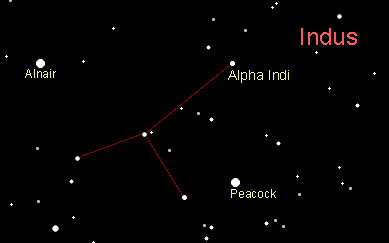
There are no very bright Stars, and no named bright Stars, in this Constellation
The brightest Star in Indus is known as the Persia, (alpha Indi), and has a magnitude of 3.11, this level of illumination gives it a fourth magnitude Star rating (there are no Stars with an apparent magnitude brighter than +3.0, located within this faint Constellation)
There are only 3 main Stars prominent in the outline of the Indus Constellation, however it has a total of 16 Stars that have been classified under the Johann Bayer Flamsteed system of naming Stars in the night sky.
The brightest Stars in any Constellation are listed and named in order of luminosity, using the Bayer designation system, from the brightest Star to the faintest Star.
A Bayer designation for a Star is where the ‘Alpha’ letter is normally allocated to the brightest star in front of its Latin genitive name (indi), then ‘Beta’ and so on in decreasing order through the letters of the Greek alphabet (although not all the Greek letters are used in every constellation).
Quick Facts about Indus Constellation:
- In the Constellation of Indus the brightest Star is named The Persian, Alpha indi, and is an Orange Giant Star in a multiple Star System. It is located around 98.3 light years from our solar system. Alpha indi hasan apparent visual magnitude of 3.11, visible by the naked eye. It is estimated to be around 1 billion years old with twice the mass of the Sun.
- The second brightest Star is called ‘Beta indi’, and is a K-type bright giant Star that’s around 600 light years distant it has an apparent magnitude of 3,67 it is visible by the naked eye
- The 5 bright Stars forming the outline shape are alpha indi, beta indi, theta, delta indi and eta indi
- Indus does not have any Stars ranked in the 100 brightest stars in the solar system
- Indus has 2 third magnitude Stars and 3 fourth magnitude Stars (those are the brightest listed in Indus)
- The closest Star is Epsilon indi is located only 11.8 light years from Earth
- The furthest Star is located around 612 light years away
- There are 19 Stars in Indus that are visible by the naked eye in a clear dark night sky. Although none of these Southern Stars Indus have an apparent magnitude greater than a fourth magnitude classification. (Stars with a visual magnitude of up to +6.5 are considered visible by naked eye)
- A total of 950 Stars have been identified and scanned by the Hipparcos satellite but not all are visible by the naked eye.
FACT: it is assumed that the dimmest Star visibly the naked eye is one with a magnitude of +6.0 (although some references say the apparent magnitude for naked eye visibility of a Star is as much as +6.5)
The Shape
The Indus Constellation can be identified in the night sky, as a near perfect triangle with a North-South complex scope, formed by the position of the 3 main Stars – alpha indi, beta indi and delta indi.
The Southern stars of Indus can be viewed from Earth, from a variety of locations, from a Southern location in the evening, by the naked eye.
The Star System within Indus
There are no named Stars within Constellation Indus that are approved by the IAU, although the alpha indi Star is sometimes known as The Persian.
FACT: Star names come from many different cultures and their stories and beliefs. Many Star names date back to ancient times and are still used today. All of the official Star names have to be approved by the IAU, and most traditional Star names are in Arabic
The Constellation of Fornax does not have any formally approved named Stars.
The notable stars forming the overall shape of Indus are:
- The Persian, Alpha indi (a indi) – an Orange Giant Star is the brightest star in Indus, and 101 light years away
- Beta Indi (b indi) – the second brightest in Indus, is also an Orange Giant Star, 600 light years distant
- Delta indi, (d indi) – a single white Star, 185 light years distant from Earth
The Location of Indus
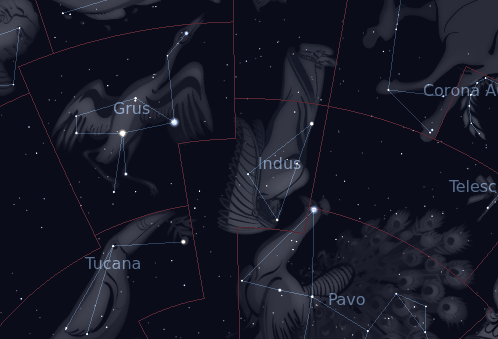
This Constellation can be spotted in the Southern Hemisphere, also referred to as the Southern celestial sky.
The Constellation Indus is surrounded by various recognizable Constellations namely
- Grus;
- Microscopium;
- Sagittarius;
- Telescopium;
- Tucana;
- Pavo
- Octans
The identifiable outlines of these Constellations are used as a guide-point in the sky used by astronomers and amateur stargazers to identify certain Deep Sky Objects of interest.
The naming of Indus
Indus is thought of with the name ‘the Indian’.
It was the Dutch astronomer Petrus Plancius who created the constellation of Indus
Indus is a member of ‘the Johann Bayer family of Constellations that includes (in alphabetical order):
What’s within the Indus Constellation?
The different components usually housed byConstellationsare mainly Stars, Deep Sky Objects and Messier objects (galaxies).
The Constellation of Indus is formed by of a number of different components, it has:
- 3 main Stars
- 0 formally named Stars
- 2 stars that host an exoplanet
- 0 associated meteor showers
- 0 Messier Objects
The Stars
There are many different types of Stars in the star system categorized by size, lifespan and luminosity.
Generally, larger Stars have a shorter lifespan.
Stars are formed from clouds of interstellar gas and include:
Red Dwarf Stars
Most of the stars in the galaxy are Red Dwarf Stars. They are small in size measuring about 40-50% of the mass of The Sun. They are cool and their luminosity has only about 10% of the brightness of the Sun (our brightest Star), and they live for longer.
Brown Dwarf Stars
These are known as failed stars that form like other stars but don’t reach the mass, heat or density to begin the nuclear fusion process. They are only about 8% of the mass of the Sun and are red not brown, and not easy to spot in the night sky.
Red Giant Stars
These are giant luminous stars that have a low or medium mass. A Red Giant Star is formed when a star expands its volume by fusing all of its hydrogen into helium, and then burning the helium to produce carbon and oxygen to expand.
Blue Giants
These are giant, bright stars that range from 10-100 times the size of the Sun and are 1000 times brighter. They are big and hot and therefore burn out quickly. The biggest are called Blue super giants or hyper giants. The biggest ever discovered was about 10 million times brighter than the Sun,
Yellow Dwarfs
These are main-sequence stars like the Sun, but only 80% of its size, and are bright stars,
White Dwarfs
These are small burnt out husks of stars, about the same size as the Earth. White Dwarfs are dense and represent the final state of evolution for a star, like most stars in the galaxy.
Black Dwarfs
These are the remains of a White Dwarf after it cools and darkens. This is likely to happen after about 10 billion years of life.
White Stars
These are also main-sequence stars like the Sun, but twice the size, and are bright stars and hot.
Other types of stars include the Orange Giant, Neutron stars, Variable Stars and Binary Stars
What is a Bright Star?
The sky is home to various bright stars.
The brightness of a star is measured by a value called its magnitude (apparent magnitude) and they come in different sizes, composition, mass and color.
Their vast distance away from us is measured in light years from the Earth, the Sun or even the Milky Way. The lower the magnitude value the brighter the star appears in the night sky when viewed from Earth.
Locating its 3 brightest Stars, alpha indi, beta indi and delta indi can identify The Constellation of Indus as a right-angled triangle
As well as Stars and Star Clusters, the Indus Constellation also has deep sky objects and galaxies (or even globular clusters or open clusters).
Deep Sky Objects
The notable deep sky objects, includes objects from the Henry Draper Catalogue of Stars (abbreviated to HD and a designated number as an identifier), or the Index catalogue classification (IC)
FACT: A Deep Sky Object is an astronomical object, that is not a solar system object like the Sun, Moon, Comet or a Planet. An individual Star is not considered to be a Deep Sky Object.
Deep Sky Objects are faint objects that can still be observed by the naked eye in the night sky from Earth.
Deep Sky Objects include Galaxies, Star Clusters and Nebulae.
- Star clusters – such as Globular Clusters of Stars or Open Clusters of Stars
- Dark Nebula, Planetary Nebula, Diffuse Nebula, and Supernova remnants
- Galaxy Groups, Galaxies, Spiral Galaxies, Gravitational Lenses and Quasars
What is a Messier Object?
A Messier is a cluster of Stars
It was Charles Messier, a French astronomer, whois credited with cataloging each of the Messier Star clusters, around 1764.
He is famous for publishing an astronomical catalogue that lists 110 nebulae and star clusters, known as the New General Catalogue (used in its abbreviated form NGC and numbered).
There are no Messier object star clusters within Constellation Indus, but there are some NGC listed objects and notable galaxies:
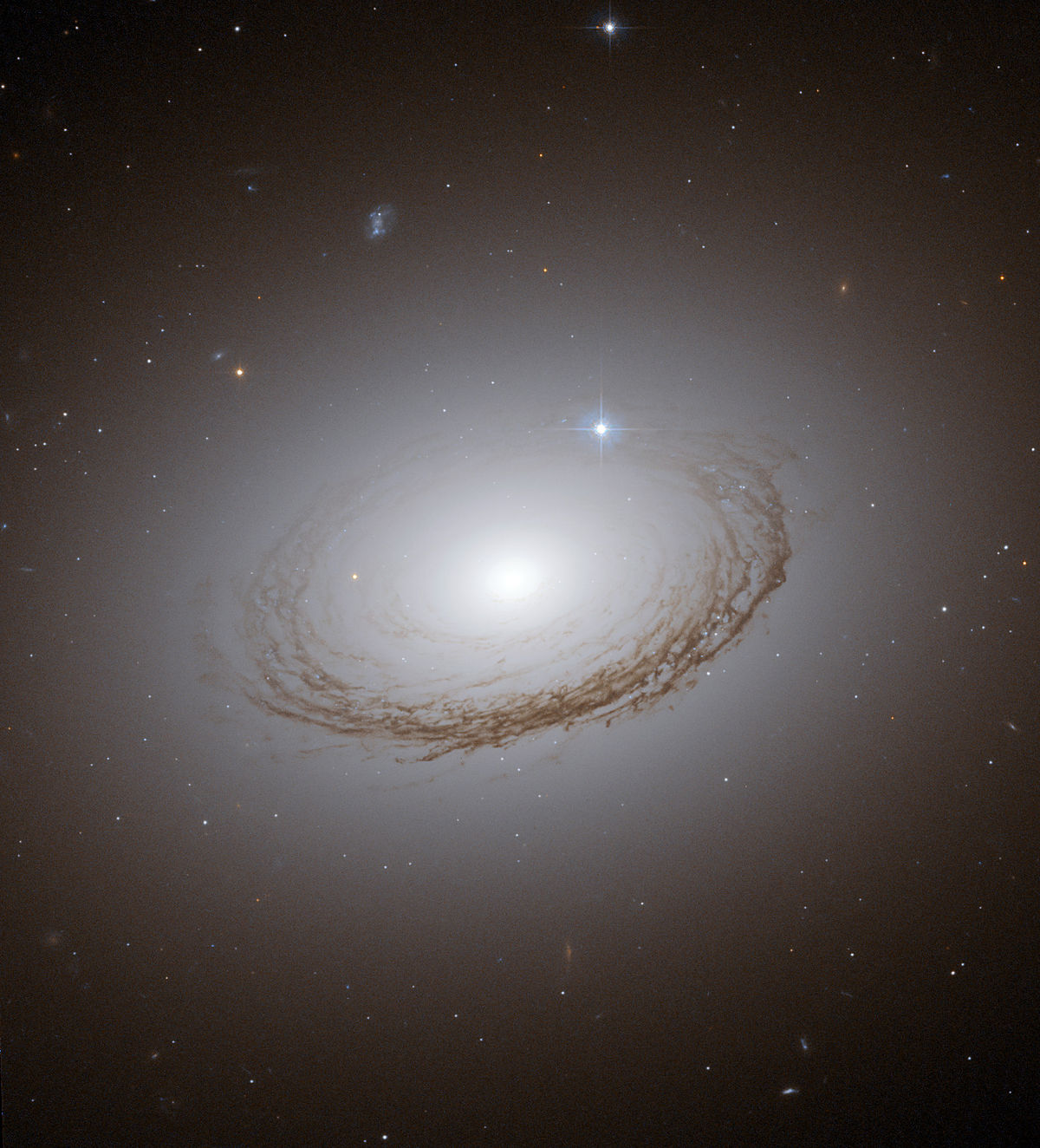
NGC 7049
- NGC 7049 – is a galaxy located around 100 million light years distant from Earth with a span of around 150,000 light years. It has a prominent dust ring around it and it appears like a spiral galaxy and an elliptical galaxy.
The unusual shape of NGC 7049 may be due to recent collisions with other galaxies. The top star in this galaxy if actually located within the Milky Way
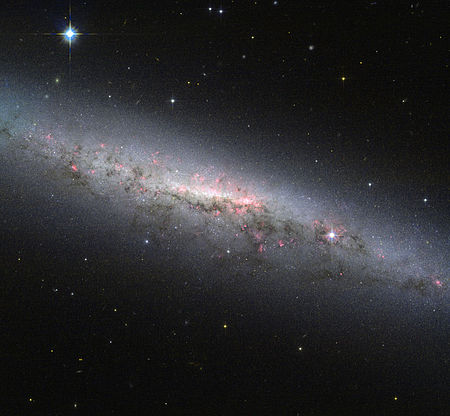
NGC 7090
- NGC 7090 – is a spiral galaxy, located around 30 million light years distant. It has an apparent magnitude of 10.51
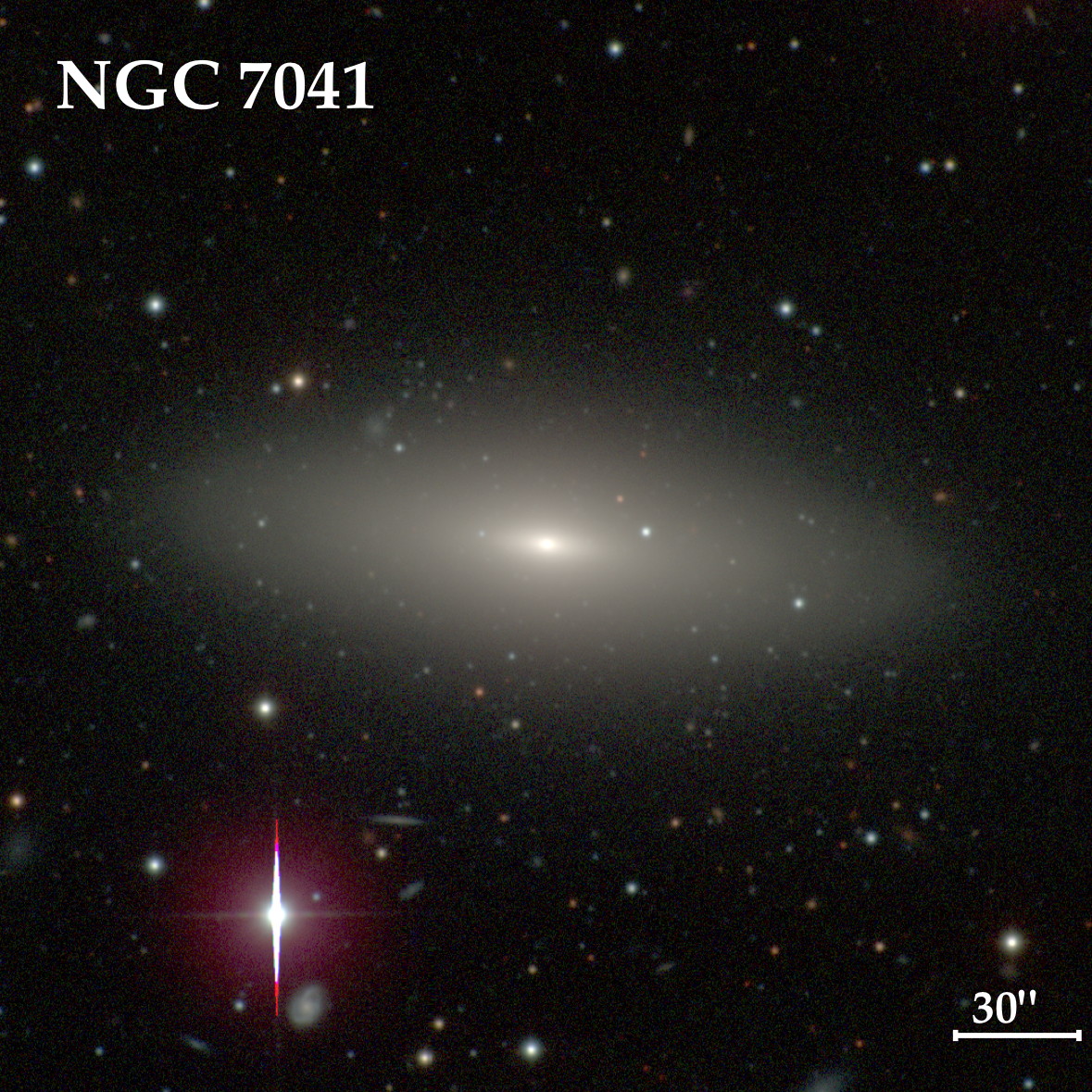
NGC 7041
- NGC 7041 – Is a lenticular galaxy that has a visual magnitude of 11.1. It is located roughly 80 million light years away!
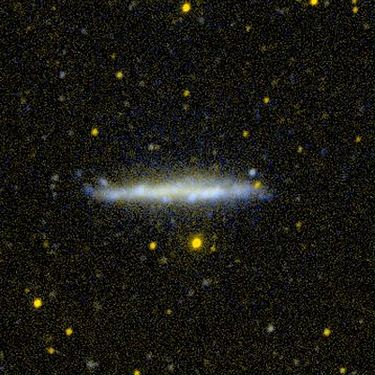
NGC 7064
- NGC 7064 – is a barred spiral galaxy with an apparent magnitude of 12.2. It has an estimated diameter of 51,000 light years, roughly half the diameter of the Milky Way.
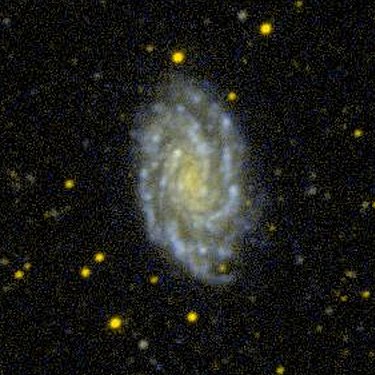
NGC 7083
- NGC 7083 – is a barred spiral galaxy, with an apparent magnitude of 12. It is considered to be a grand design spiral galaxy.
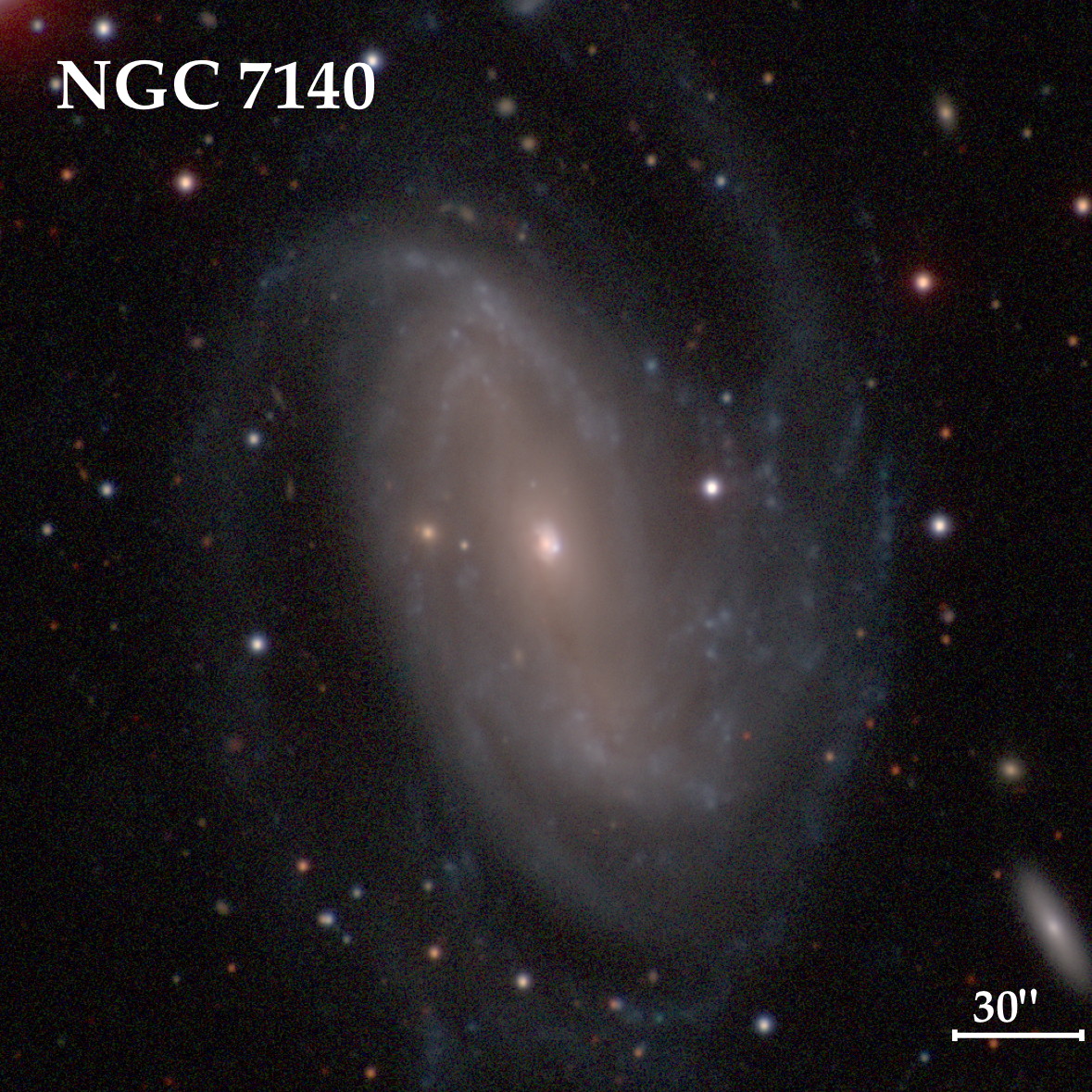
NCG 7140
- NCG 7140 – is a spiral galaxy, which was discovered by the British astronomer John Herschel during his studies in the Cape of Good Hope, in South Africa in 1834. It has a visual magnitude of 11.7 and is located around 122 million light years from Earth.
FACT: A star cluster is a large group of Stars that can be Globular Clusters or Open Clusters:
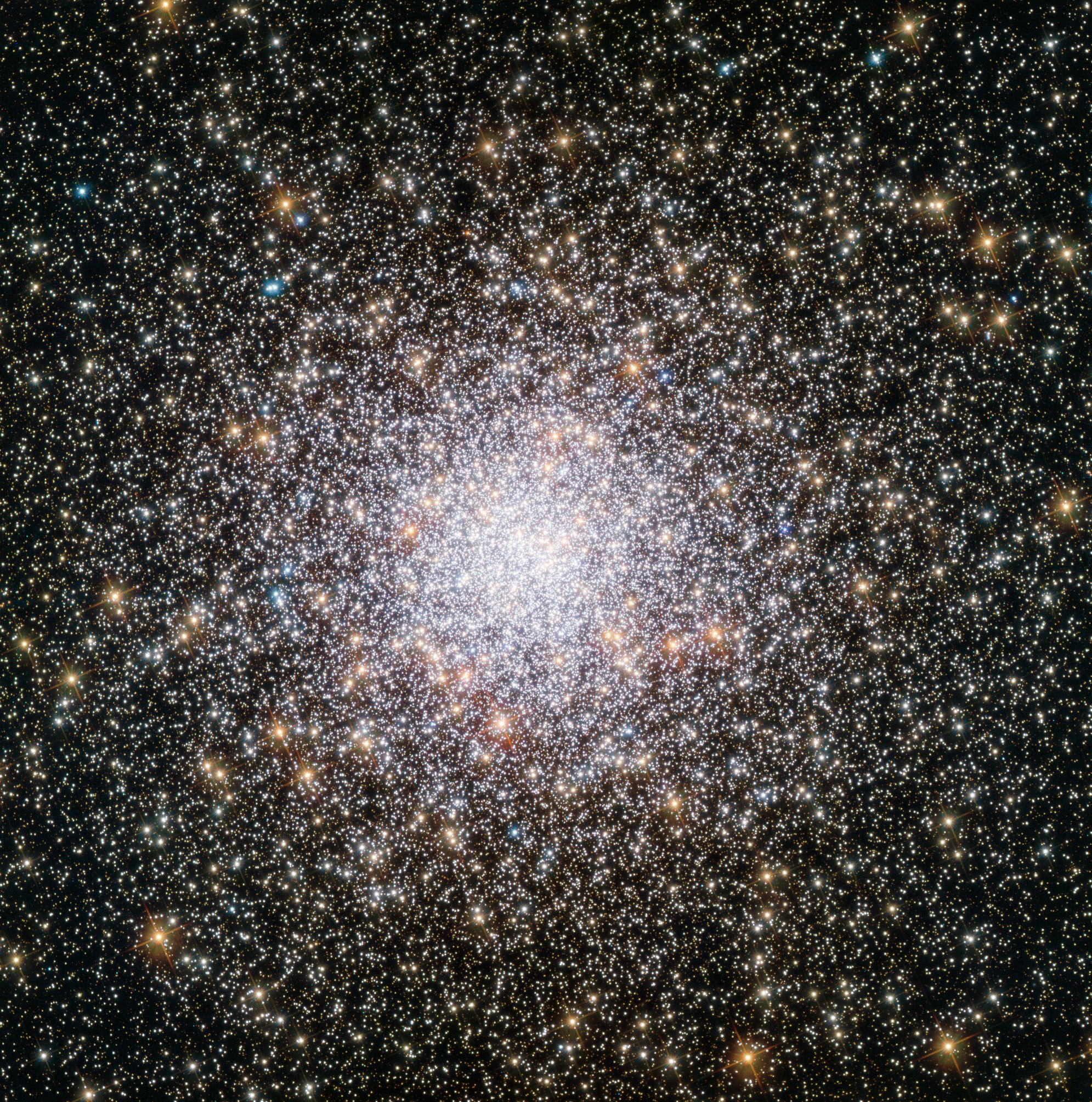
- Globular Clusters:
A global cluster is a spherical collection of ‘Old Stars,’ numbering hundreds to millions, that are tightly bound by gravity and orbits a galactic core.
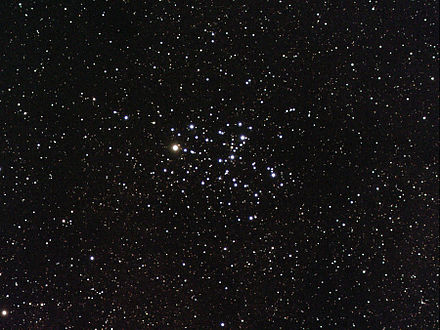
- Open Clusters:
An open cluster is a looser formation of ‘Young Stars’ that generally has less than a few hundred Stars.
What is the Milky Way?
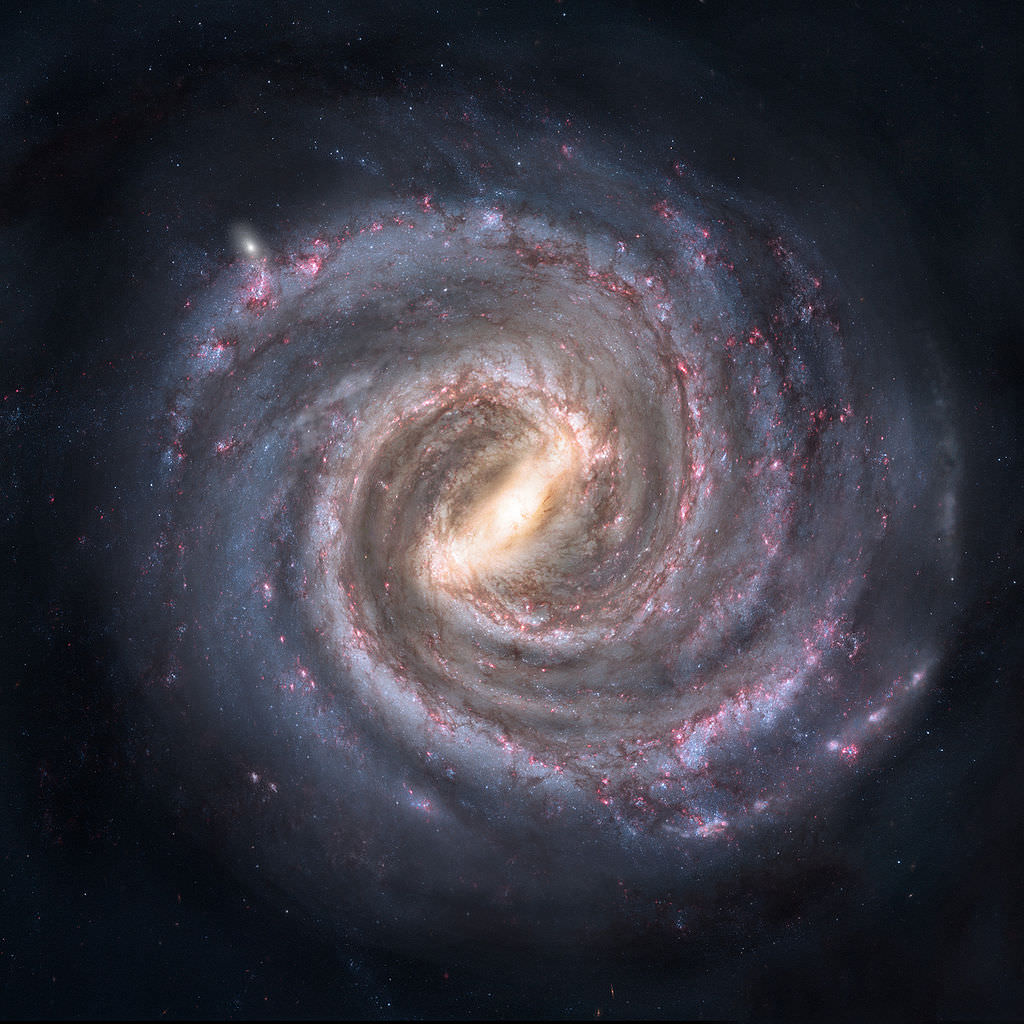
The Milky Way is a Spiral Galaxy, containing over 200 billion Stars, and actually forms part of the Constellation of Sagittarius. It is the Galaxy that contains our solar system and it gets its name from the fact that it looks like a hazy swirl or river of milk across the sky, when viewed from earth.
It is made up of gas, dust and stars, with spiral arms wrapped around it, and a massive black hole in the center of the Galaxy. Not all of the Stars in the Universe are contained within the Milky Way.
It is at its brightest if looking towards the galactic center in the direction of Sagittarius. The Stars that make up the Milky Way are many light years away and cannot be individually identified by the naked eye.
Background & Facts:
The Greeks were the first ancient culture to name the modern Constellations in the sky.
However, in the case of the constellation of Indus there were no associated Greek myths, nor did they mention the image of a muscular man with arrows in mythology.
Ptolemy

It was the well-known Greek Astronomer – Ptolemy, who first cataloged the 48 early constellations, in the 2nd Century (2 AD.), but he did not catalogue the Constellation of Indus
Bayer

In 1603, The German Astronomer – Johann Bayer, systematically assigned names to the brightest stars in each constellation and cataloged them in his Star atlas – ‘Uranometria Omnium Asterismorum’.
The Bayer designations are stellar designations where the stars within Constellations are initially identified by a name or a letter from the Greek Alphabet from Alpha through Omega (in order of brightness).
1. The names of the Stars begin with a letter of the Greek alphabet starting with– Alpha, then beta, gamma, etc.
2. Followed by the genitive form of their parent constellation’s Latin name – ‘indi’
3. Giving the first Star name Alpha indi
The main stars of Indus are named by their apparent magnitude (luminosity) from the brightest to faintest star in decreasing order, Stars with an apparent magnitude of less than +5.06 include:
1. Alpha indi – an apparent visual magnitude of 3.11
2. Beta indi – a variable visual magnitude of 3.67
3. Theta indi- an apparent visual magnitude of 4.39
4. Delta indi– an apparent visual magnitude of 4.40
5. Eta indi – an apparent visual magnitude of 4.51
6. Epsilon indi – an apparent visual magnitude of 4.69
7. Zeta indi – an apparent visual magnitude of 4.90
8. Iota indi – an apparent visual magnitude of 5.06
Hipparcos created the apparent magnitude system to rank the brightness of Stars (for example he decided that that the grade of a first magnitude star should be twice as bright as a second magnitude Star, and so on.
FACT: The commonly quoted ‘Hipparcos Satellite’ is an abbreviation of ‘The High Precision Parallax Collecting Satellite’, which is an astrometric satellite used by the European Space Agency (ESA)
The importance of the Constellations such as Indus dates way back to the times of the Babylonians who identified constellations with bright Stars
The Bright Stars of Indus
If you look up and into the Southern night sky you can imagine the recognizable outline of the Constellation of Indus, which is imagined as an Indian.
This main constellation is made up of 39 bright Stars.
Stars with Planets
Indus has 2 Stars with an exoplanet orbiting around it in the solar system but they are unlikely to be able to support life forms.
The furthest exoplanet discovered was actually in the Andromeda Galaxy, not in the Milky Way.
Not all the stars within the Indus Constellation are visible to the naked eye but with a large telescope and other modern imagery techniques is it possible to glimpse all of the stars.
FACT: An exoplanet (also referred to as an extrasolar Planet) is a planet that orbits a Star that is not located within our Solar System (exoplanets do not orbit our Sun)
Nothing stands still in the sky.
Planets are continually being discovered and lists updated.
The Constellations change their positions throughout the year as the Earth rotates around the Sun.
This means our position in space is forever changing and as a result our view of what’s in space changes too, and will continue to do so.
What is the purpose of Indus –
In ancient times the dots, bright lights and perceived objects in the sky were of great interest and the makings of folklore to a great range of people from seamen to farmers.
From children to the elderly, we have had an ongoing fascination, with our solar system and star system. Perhaps it’s because the enormity and variety within it makes us realize just how large and exciting the universe is.
FACT: The Star System or Stellar System is a small number of stars that orbit around each other and are bound together by gravity.
When it becomes a large group of stars, again bound together in the same way, by gravity, it is known as a Galaxy or Star Cluster.
Whether they contain small groups of stars or larger groups of start the both come under the classification of ‘Star System’.
The Indus celestial pole
The celestial pole defines the poles of the celestial equatorial coordinate system.
An object at the Celestial pole has a declination of 0 degrees.
- The declinations for the north celestial pole is +90 degrees
- The declinations for the south celestial pole is -90 degrees
The celestial poles are not permanently in a fixed position against the background of the stars as everything moves in Space.
Indus is located in the Southern celestial sky at a +15 degree and -90 degrees declination, and an average 3-hours right ascension.
Navigational tools in the sky
The many Constellations in the night sky were a useful navigation tool and guide as well as the subject of legends and myths.
42 Constellations have been named after animals and 29 named after an object.
There is usually a story behind each name from ancient myths to objects that have made a difference in the world, from microscopes to characters.
Historical significance: surrounding Constellation of Indus
Myths and Stories
Many ancient civilizations have related the Constellations in the sky to suit their beliefs and creations itself. They have been the subject of folklore and experiences for a very long time.
Indus is not connected with any Greek or Roman myths or gods.
Ancient associations with the constellations
The Greeks, the Romans and the Sumerians all had an interest in the constellations in the sky.
The Sumerians were the first literate civilization of the Ancient Mesopotamia (an area occupying parts of Turkey and the Syria of today, Iraq, Iran)
The Sumerian civilization was not unified like the ancient Greek or Roman civilizations it was bonded by a common attitude.
Their belief systems featured many deities. They regarded their gods as being responsible for everything and as such held them in great respect. Many stories arose as a result.
For thousands of years, various cultures around the world have identified and named the constellation we know and see in the night sky as Indus.
The Mesopotamian civilization (the first known civilization) identified constellations like Indus.
FACT: The ancient lands of the Mesopotamians now stretches across Turkey, Syria, Iraq and Kuwait
Indusand the other constellations in the sky had a practical use.
The ancient Mesopotamians and in Asia used the orientation of the constellations to set the seasonsfor sowing crops and harvesting.
The Babylonians also recorded details of various bright stars within the constellations in their Babylonian star catalogues before 100BCE.
What is the difference between a constellation and an asterism?
An asterism is a group of stars that appear to form a pattern in the night sky but with no officially determined boundaries.
It can make up part of a constellation or cross the boundaries of an official constellation or even a defunct constellation.
An asterism is a more vague assembly of stars than a recognized constellation.
The meteor showers of Indus
There are no annual meteor showers associated with the Constellation of Indus.
Fun Facts about Constellations – Did you know that?
. The Constellation of Indus is not one of the 12 constellations of the Zodiac, that appear when the Sun sets
- Constellations have been represented in many cultures as signs and navigational guides.
- The symbol of the triangle, formed by the position of notable stars, is associated with the Constellation of Indus and also the Constellations of Triangulum and Fornax.
- The rate of formation of stars in a starburst galaxy is more than 10 times faster than the star formation in the Milky Way galaxy
- NGC 7079, the spiral galaxy in the Constellation of Indus was discovered by John Herschel an English astronomer.
- As the Indus Constellation is made up of Stars that are in many different locations and vast distances from each other it is now possible to go to just one location to view it. It is visible from many different locations.
- The average distance to the main Stars in the small Southern Constellation Fornax is around 264 light years away.
- There are over 4000 known exoplanets in the night sky, with another 5000 awaiting classification. Fornax has 6 Stars with orbiting exoplanets.
- Charles Messier the French Astronomer who cataloged the Messier objects has a crater on the Moon named after him.
- Constellations like Indus are not part of our Solar System; they are groups of stars that appear to form shapes that are visible with the naked eye from Earth.
- A Constellation does not actually exist as a fixed object, it is a group of bright stars that happen to be in a random place and are light years apart and ever moving. We see the pattern of their presence.
- The center of a Galaxy does not contain a Giant Star it contains a Supermassive Black Hole.
Commonly Asked Questions
Q. What is the celestial sphere?
A. In astronomy and navigation terms, the celestial sphere is imaginary.
This virtual sphere has a large radius that is concentric with Earth.
We can imagine all objects in the night sky as being projected upon the inside of this celestial sphere, as if it has images placed inside a dome.
Q. What’s the difference between a Constellation and an asterism?
A. The stars that make up a Constellation have a definite position and form, whereas an asterism is a collection of stars without a fixed position
Q. What prevents us seeing the Stars and Constellations in the night sky?
A. Light pollution, fog, city lights and artificial lights all limit our visibility of the objects in the sky at night.
Q. Will the Constellations change over time?
A. The Constellations are continually on the move.
The images we form in our imagination to make objects, shapes and patterns out of the constellations have already shifted over time.
As we view the night skies from Earth they are likely to continue to shift and possibly in time the images may look very different.
Sources:
- https://www.vectorstock.com/royalty-free-vector/indus-constellation-starry-night-sky-cluster-of-vector-26526645
- https://web.pa.msu.edu/people/horvatin/Astronomy_Facts/constellation_pages/indus.htm
- https://in-the-sky.org/data/constellation.php?id=45
- https://en.wikipedia.org/wiki/NGC_7049
- https://en.wikipedia.org/wiki/NGC_7090
- https://cgs.obs.carnegiescience.edu/CGS/object_html_pages/NGC7041.html
- https://en.wikipedia.org/wiki/NGC_7064
- https://en.wikipedia.org/wiki/NGC_7083
- https://cgs.obs.carnegiescience.edu/CGS/object_html_pages/NGC7140.html
- https://astronomynow.com/2016/10/24/hubble-reveals-ngc-362-a-young-globular-cluster
- https://www.wikiwand.com/en/List_of_open_clusters
- https://www.universetoday.com/106062/what-is-the-milky-way-2
- http://www.hellenicaworld.com/Greece/Science/en/PtolemyAstronomy.html
- https://alchetron.com/Johann-Bayer